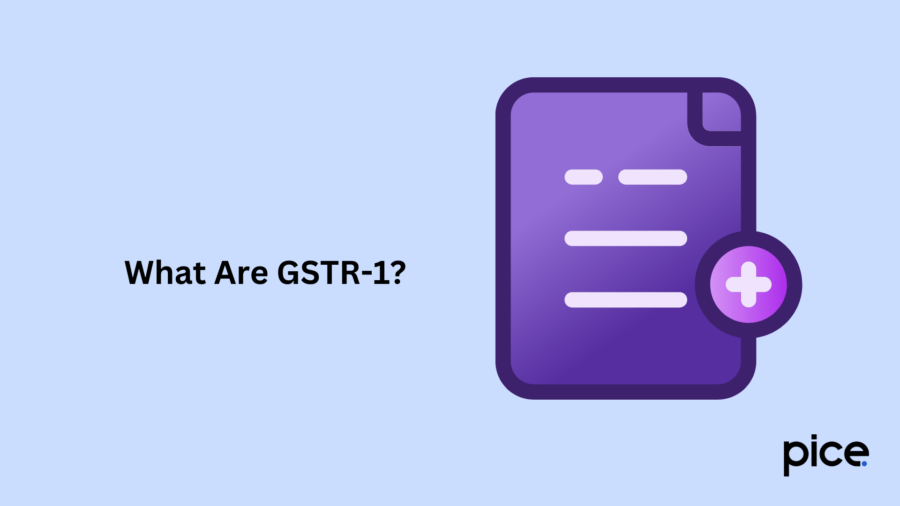How to Add Missing Invoice in GSTR 1 After Filing?
- 16 Dec 24
- 9 mins

How to Add Missing Invoice in GSTR 1 After Filing?
Key Takeaways
- Maintain accurate invoice records to ensure seamless GSTR-1 compliance.
- Address missing invoices promptly in subsequent GSTR-1 or GSTR-3B filings.
- Avoid non-compliance to prevent penalties, cash flow issues, and reputational damage.
- Use GST software and reconcile data to simplify filing and reduce errors.
- Seek professional help to stay updated and ensure timely GST compliance.
Although the applications and scope of GST were deemed complex from the start, the Indian Government still thought it would be appropriate to build a connected finance ecosystem. However, the registered taxpayers even today face various issues while completing GST return filing.
Many forms and original invoices must be uploaded while filing a GST return claim. If you are familiar with the process, you may have already heard about form GSTR-1 necessary to claim accurate returns. It associates a range of invoices that must be manually submitted while claiming annual returns.
If you are trying to figure out how to add a missing invoice in GSTR-1 after filing on the online portal, then this blog will definitely help you. We have offered a comprehensive guide to navigate the discrepancies in your form for the relevant month. So, let us begin by first discussing what a GSTR-1 means.
What Are GSTR-1?

GSTR-1 falls among the list of crucial returns under the GST legislation in India. Every GST-registered taxpayer needs to submit this form either as quarterly returns or monthly returns. Only a few categories of businessmen are exempted from the obligation to file returns via GSTR-1 as outlined by the liability details in GST law.
The main objective of GSTR-1 is to offer particulars of all outward taxable supplies for a particular return period. It is one of the key returns that help maintain transparency and assist the Government in collecting the right amount of tax.
Why Is GSTR-1 Important?
GSTR-1 is given the utmost preference by taxpayers as well as the Government because it provides a top-to-bottom record of any business’ cumulative outward supplies. Its significance is associated with multiple aspects, such as:
- Real-time Status Monitoring
GSTR-1 offers real-time data on returns filed under a particular GST Identification Number (GSTIN). One of the main advantages of the feature is that it enables users to receive constant notifications on the status of their tax liabilities.
- Cross-GSTIN and Branch Comparison
GSTR-1 can be used by users to cross-verify data for more than one GSTIN and branch. This feature is particularly useful for complex firms in terms of numerous operations, as it allows one to have an overall view of the aspect of compliance at different levels of operation.
- Compliance Tracking and GST Notices Prevention
GSTR-1 is an extremely useful record for taxpayers to monitor their levels of GST compliance. To mitigate the risk of tax notices, businesses can thoroughly review and file all necessary documents to prevent errors in their tax returns.
- Facilitation and Stakeholder Communication
The information contained in the GSTR-1 enables the businesses to give clear and specific details to the stakeholders for example vendors, customers and bankers. Integrated reporting strengthens the quality of reported information and increases trust between business owners.
- Audit Preparedness
Filing the GSTR-1 form on time helps in audit preparedness. So, even in the midst of a GSTR-1 audit, the relevant records will be streamlined and any errors that may exist will be minimal. Hence, the entire process is seen as an ideal exercise in compliance.
- Avoidance of Penalties and Interest
Filing the GSTR-1 on time and accurately helps a business avoid penalties and interest which accrue where compliance is late or non-existent. When taxpayers meet regulatory deadlines, they will attempt to avoid adverse financial effects due to non-compliance by imposing effective financial discipline.
What Do You Do if You Have Missing Invoices in Your GSTR-1?
In case, you find out that some of the invoices have been left out or you have neither uploaded them in your GSTR-1 filing, this is a problem that has to be addressed fast. As opposed to some of the other tax return procedures, the new GST return regulations do not allow for the amendment of a filed GSTR-1. Thus to tackle a discrepancy, the earlier omitted invoices should be taken into account in the upcoming filing period.
Second and more importantly, the actual tax liability and payment are presently determined based on the data provided in GSTR-3B. Thus, maintaining preciseness here is critical. If the invoices are missing in GSTR-1, you have the option to include them in GSTR-3B.
But what if the same invoices are also accidentally left out in the GSTR-3B current tax period?
In that case, you must mention these items in the subsequent GSTR-3B to be filed in the next quarter or month. This ensures the correct declaration of tax amount by the return filer and helps them stay compliant with GST requirements.
What Is the Impact of Missing Invoices on Business?

If you do not know how to add a missing invoice in GSTR-1 after filing, it can cause substantial adversities for your business. Here’s a quick breakdown of some of the potential consequences:
- Reduced Cash Flow
Missed invoices distort your customer’s payment deadlines which, in turn, affects your cash flow and incapacitates you to meet operating expenses, employee salaries or capital investments. This can culminate in delayed payments to suppliers which further extends your business’s struggle with its cash flow.
- Tax Liabilities and Penalties
If you forget to include valid invoices in return forms, it can mess up your sales and purchase records. This may alert the taxing authorities during a tax audit. It is also important to stress that if there are certain discrepancies in the reported data to the actual transactions it can lead to fines or interest charges and at some stage attract legal consequences.
- Inventory Management Issues
When there are inadequate valid invoices, checking inventory becomes difficult. This can result in stockouts, loss of sales opportunities and internal stock crises which put more stress on the employees.
- Operational Inefficiencies
Dealing with all the missing invoice issues takes time and resources away from your main work, which affects how productive and efficient your business could have been.
- Damaged Reputation
Failure to issue or report accurate invoice records is a red flag for any company since it leads to a loss of credibility among the clients. This can be counterproductive because it affects the business relations with and between customers, partners, end users, suppliers and even potential investors.
- Reduced Input Tax Credit (ITC) Claims
Missing correct invoices or bills denies you opportunities to recover input tax credit (ITC) on the corresponding purchases, thereby resulting in higher taxes and constrained profitability. It is most damaging to enterprises that have a significant to optimise ITC benefits.
What Are the Best Practices for GSTR-1 Filing?
Filing GSTR-1 precisely and on time is crucial to maintaining GST compliance. Here are some best practices to follow:
During Return Preparation:
- Maintain Accurate Reporting of Sales: Keep detailed records of all outward supplies, including invoices, rate of GST, credit notes/debit notes and export documents.
- Verify GSTINs: Ensure the accuracy of all GSTINs of suppliers and recipients in the return file.
- Correct HSN Codes: Use the correct HSN/original state codes for each product or service to avoid discrepancies.
- Reconcile Data: Regularly reconcile your accounting records with the data to be entered in GSTR-1.
During the Filing or Return Process:
- Utilise GST Software: You can use reliable GST software to streamline the filing process and reduce errors.
- File on Time: It is mandatory to adhere to the due dates for filing to avoid penalties and additional interest charges.
- Review and Verify: Finally, you must review all the invoice details with GST supplies entered in GSTR-1 before submitting.
- Consider Professional Help: If you find the process complex, it is better to consult a tax professional for assistance.
Post-Filing:
- Retain Original Invoice Records: Ensure to keep physical or digital copies of all records related to GSTR-1 invoices issued to the receiver of supplies.
- Monitor Notices and Refunds: All GST-registered persons need to regularly check the unified portal for any notices, refund status updates or declaration of dates.
- Stay Updated with GST Rules: Lastly, a regular taxpayer must stay informed about the latest GST rules and regulations to ensure direct tax compliance and avoid late payments.
By following these best practices, one can ensure accurate and timely GSTR-1 filing, minimising the risk of penalties and frequent audits.
Conclusion
To comply with GST laws and ensure smooth business operations in the Indian finance ecosystem, timely filing of the GSTR-1 form is crucial. In this context, understanding how to add a missing invoice in GSTR-1 after filing becomes beneficial for maintaining a proactive approach to compliance and avoiding potential tax notices.
Thus, as a starting point, you can get help from professionals to ensure 100% direct tax compliance.
💡If you want to streamline your payment and make GST payments, consider using the PICE App. Explore the PICE App today and take your business to new heights.
 By
By 

















